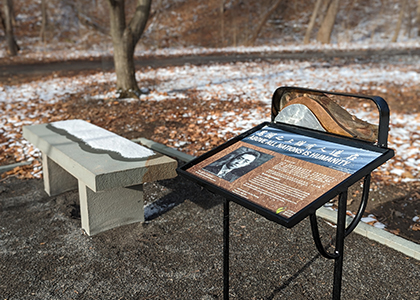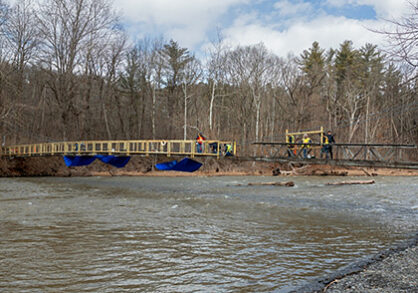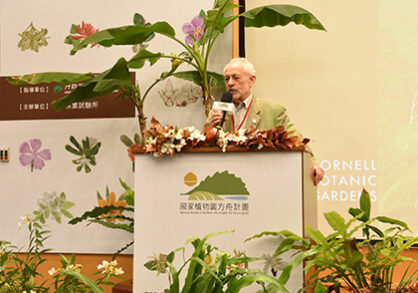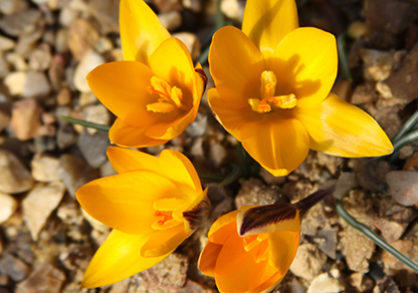
While a student at Cornell, Hu Shih 1914, imagined and later led a literary movement resulting in the adoption of a common, accessible language in China.
In admiration of the contributions of Hu Shih 1914, friends and alumni of Cornell funded an outdoor seating area for quiet and contemplation on the banks of Beebe Lake. A stone bench and interpretive sign invite community members to the northwest corner of Beebe Lake, where they can learn more about Hu Shih.
After graduating from Cornell, Hu Shih led a literary movement that helped transform China. At the time, China embraced two forms of language: the classical literary language, which was used for all written purposes; and the vernacular, which was spoken. The former was literary and unintelligible to most, while the vernacular was a language that any literate person could read.
Hu Shih’s advocacy for the accessible vernacular language sparked a literary movement in China. This began the process of freeing China from what became thought of as a “dead language.” The language reforms that emerged with Hu Shih at Cornell went on to change an entire nation.
Hu Shih drew inspiration from Cornell’s exceptional natural beauty. He is believed to have experienced a breakthrough moment following the capsizing of his canoe—or perhaps a rowboat on Cayuga Lake. In December 1947, Time magazine reported the incident:
When a storm swamped a rowboat on Cayuga Lake in 1916, a young Cornell man named Hu Shih got a ducking. To memorialize the immersion, a soaking compatriot composed a poem in literary Chinese. Its mannered, delicate style seemed so ill-suited to the topic that young Hu dashed off some lustier lines of his own. They were written in Pai Hua (the living speech) instead of Wen Li (the literary language), and they were good. Until Hu did it, no one believed that serious literature could be made from, Pai Hua, as Dante had from Italian.
More than 60 donors joined together to share their admiration of Hu Shih with the Cornell community and invite others to learn how Cornell inspired him to lead a language revolution in China. Huaiyu Liu MBA ’97, Robert B. and Caroline D. Eckhardt, and Xiaolin Zang led the fundraising for a stone bench and an interpretive sign and audio narrative in both English and Mandarin. Local artist Durand Van Doren forged the base of the sign to reflect its lakeside setting.
“Beebe Lake is among the natural settings appreciated and enjoyed by Hu Shih,” said Zang, a volunteer for the Hu Shih Memorial Foundation, which organized the fundraising and collaborated with Cornell Botanic Gardens throughout the project. “This seating area creates an opportunity for future generations to both learn about Hu Shih and experience the inspiration of nature, as he did.”
For more Hu Shih’s transformation of language in China and how his time at Cornell influenced this work, visit the Hu Shih Memorial Foundation site and listen to the audio narrative created for the bench installation.
Repairs to Flat Rock Bridge span two generations
A newly restored footbridge over Fall Creek serves as the most direct access point for more than 20 miles of Cornell Botanic Gardens trails and is used by 35,000 visitors a year.
International collaboration strengthens conservation actions for threatened plants
Taiwan News—March 22, 2023
Christopher Dunn and other directors and representatives of nationally important botanical gardens spoke at the international symposium “Plant Ark: 2023 Taiwan Botanical Garden Conservation Action” in Taipei.
Native plants of Ukraine connect us
Draw closer to the plants and people of Ukraine by walking among their native plants, in digital plant collection.


